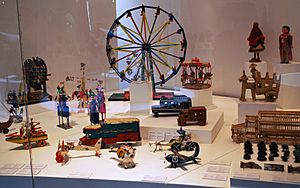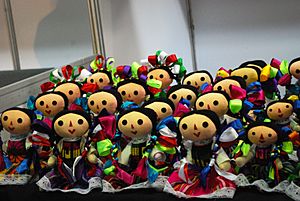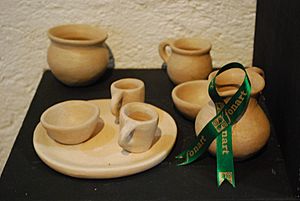Traditional Mexican handcrafted toys facts for kids
Traditional Mexican handcrafted toys are special toys made by skilled artists, not in big factories. Their history goes way back to ancient times in Mesoamerica, even before Europeans arrived. Many of these toys became popular during the colonial period. Missionaries often used them to teach children about new ideas, and they were linked to special holidays and celebrations.
These toys come in many forms, like cup and ball games, lotería cards, dolls, tiny people, animals, and objects. They are made from different materials such as wood, metal, cloth, corn husks, clay, and glass. These handmade toys were very popular across Mexico until the mid-1900s. That's when plastic toys, made in factories, became common and cheaper. Today, traditional toys are mostly sold as unique gifts to tourists and people who collect them.
Contents
Discovering Mexican Toy Types
Mexico has a huge variety of traditional toys, more than many other countries! They are made from many materials. These include wood, cloth, tin, papier-mâché (called cartonería), porcelain, clay, palm leaves, corn husks, straw, seeds, and even scrap metal. This is especially true for tiny miniature toys.
Mexican toys often have simple designs and bright, happy colors. It's unique that Mexico has so many toys made from fired clay, especially in Oaxaca. Toys made from a very hard papier-mâché, called cartonería, have a long history in Mexico. These include dolls, horse figures, piñatas, toy swords, and masks. Most of these are made in Silao and Celaya. In Mexico City, artists also make items like piggy banks and bird figures from cartonería. These toys are usually made by pressing the treated paper over special molds.
Common traditional toys include wooden tops, yo-yos, cup and ball games, marionettes, and hobby horses. You might also find marbles, whistles, wooden and tin trains, rag dolls, and slingshots. Some toys are miniature versions of real things, like buses, dollhouses, and doll kitchens. There are even detailed miniatures like tiny carousels and ferris wheels. Popular traditional board games are oca and the widely played lotería game. Lotería is interesting because its cards show both good and sometimes scary images, like devils and scorpions.
Exploring Mexican Dolls
Dolls are a very important type of traditional toy in Mexico. They are made from different materials and some have become famous. Oaxaca is known for its rag dolls dressed in traditional local clothes. In Mexico City, dolls called “Marías” are also made from cloth. They look like Mazahua women, an indigenous group from the State of Mexico and Michoacán. These dolls often carry tiny babies and are decorated with ribbons. María dolls are well-known among tourists in Mexico. They are often sold on the street by the women who make them. These dolls are culturally important because they show a traditional Mexican image. This is different from dolls made in factories.
Less known are cartonería dolls, also called Lupita dolls. They are made from very hard papier-mâché. These dolls were first made to copy expensive porcelain dolls from Europe. Another European-style doll is the marionette. Traditional marionettes are made in Puebla. Their bodies are made of brightly colored cloth, but their hands, feet, and heads are ceramic. They often look like witches, bullfighters, devils, horses, or clowns. They also show famous characters like Don Juan Tenorio. Marionettes were used in puppet shows, often performed by traveling groups at fairs and parties. Small home puppet theaters were popular in the 1800s and mid-1900s. They were also used to teach children about Catholic beliefs. In the early 1900s, marionettes also included modern characters like Popeye and Charlie Chaplin.
Small dolls are also made from corn husks. The husks are wrapped around bunched grasses or a corncob. After they are put together, the dolls are painted with bright colors.
When the Barbie doll came to Mexico, it quickly became more popular than traditional dolls like the Lupita dolls. However, many artists still make dolls by hand from different materials. They often create new designs. For example, Blanca Molina designs about fifty different kinds of dolls each year. She makes about 200 dolls herself, which are sold in special stores. Ana Karen Allende is a doll maker in Mexico City. She makes traditional dolls, but her most popular items are male and female lucha libre wrestlers. She also makes figures of aluxes, chaneques, calacas, and Mayan guardians. Each doll she makes is unique. The Miss Lupita project, led by Carolina Esparragoza, received government help to hold workshops. Their goal is to bring back the tradition of making Lupita dolls in Mexico City with new designs.
Tiny Worlds: Mexican Miniatures
The most common traditional toys still made today are miniatures. These are tiny copies of real people, animals, and objects. They are often sold as collectibles. You can find miniature bows and arrows, cooking tools, and other tiny objects. They are made from many materials, including clay, wood, and metal. They can be sold alone or in sets that show scenes like weddings, bullfights, or battles.
Angel Carranza, born in Tlaquepaque in 1901, was an important creator of miniatures. His work is mostly made of glass. These include sets that show weddings, baptisms, market scenes, and Nativity scenes. Mexican toys often give us a lot of information about Mexican culture. Miniature market scenes, like those made by the Aguilar family in Ocotlán, Oaxaca, are models of real-life markets. This makes them very helpful for understanding Mexican culture better.
Special miniatures include musical instruments from Ixmiquilpan, glass miniatures from Toluca and Guadalajara, and woven miniatures from palm leaves in Chigmecatitlan. Some tiny animals are even carved from peach pits!
Toys for Festivals and Celebrations
Many toys were once linked to specific festivals. Some are still found today. For example, cartonería masks for Carnival and small palm-leaf mules for Corpus Christi are not as common now. These mules were sold outside churches, carrying tiny fruits and vegetables.
Toys still found today (though many are now plastic) include rachets, whistles, and cardboard periscopes for Holy Week. Horns for Independence Day used to be made of cartonería, decorated in national colors. Now, most are plastic. Two toys that remain popular are the Judas figure for Holy Saturday and piñatas. Piñatas were first used for Las Posadas but are now also used for birthdays. Both are filled with candy for children to grab when they are broken. The Judas figure (often a devil or an unpopular person) is destroyed with fireworks. The piñata is broken by blindfolded children hitting it with a stick.
Where Mexican Toys Are Made
Many places in Mexico are famous for their handmade toys. Atzompa makes toy animals like coyotes, monkeys, and bulls. Many of these animals are shown playing musical instruments. Juchitan creates small dolls with simple blue-and-white designs. Tehuantepec still makes ancient tangu-yu dolls.
In Jalisco’s main ceramic towns, Tlaquepaque and Tonalá, many toys are known for looking very real. These include tiny charros on horseback, mariachis, and famous people. They also make sets that show scenes like weddings and bullfights. Popular animal toys include armadillos, birds, cats, and piggy banks. In Michoacán, animals and other figures are made with funny or scary features, including monsters and demons in bright colors. Yalita, Guerrero makes animal figures like ducks and lions, with both realistic and fantastic features. These are often decorated with flowers, leaves, and even other tiny animals.
Artists in Metepec, State of Mexico, make miniatures from shiny black clay. They are often decorated with gold and red designs. Acatlán, Puebla makes tiny ceramic Mexican kitchen sets. In Oaxaca, traditional wooden toys are roughly cut or carved and painted. Arrosula makes a figure with a charro hat called a “gallero” (rooster handler) with movable arms. It usually comes with toy roosters. Salitla, Guerrero makes wooden toys, mostly animal figures painted wine-red and magenta. These include rabbits, birds, flowers, and leaves. Ixtapan de la Sal and Tonatico in the State of Mexico make animal figures from a local white wood.
Wooden toys are very popular in Michoacán. In Paracho, they make tops, cup-and-balls, yo-yos, and dreidels. Most are made from a wood called tzirimu. This is the same wood used to make canoes and fish nets in the Lake Pátzcuaro area. Tizatlán in the city of Tlaxcala makes Mikado (pick up stick games) from quince tree wood.
In the state of Morelos, miniature buildings are made, especially in the Cuernavaca and Tepoztlán areas. These include tiny houses, castles, and churches. They are made from scrap materials like wood pieces, thorns, and other plant parts. Aguascalientes makes metal figures of fighters or boxers that move to look like they are fighting. San Miguel de Allende makes soldier and musician figures from thin metal, painted in bright colors. In Mexico City and Oaxaca, many animal figures are made of sheet metal. These include roosters, horses, and butterflies, painted with bright enamels. Santa Clara del Cobre makes tiny pots, pans, and dishes from copper. Lead miniature soldiers and other figures are made in Puebla, Celaya, Guadalajara, and Mexico City. Guadalajara makes glass toys like dish sets, doll parts, and animal figures. The glass can be colored or clear. Alfayucan, Puebla, and the Mezquital Valley in Hidalgo weave figures from palm leaves, reeds, and straw. They make small birds, baskets, and cradles. Clay banks shaped like pigs and other animals are still made in places like Tlaquepaque. Artisans in San Cristóbal de las Casas and Berriozábal also make traditional toys.
The Toy Market Today
Mexico has a big market for toys, especially for children on Three King’s Day. However, this market usually doesn't include traditional handmade toys. Most toys sold and played with in Mexico today are made in factories from plastic, often imported from places like China.
Mexico is one of the world's largest toy producers, but most of these are also factory-made. This part of the toy industry is getting smaller. Traditional handmade toys have lost most of their market to commercial toys for two main reasons. First, big companies don't advertise them on TV. Because of this, many Mexican children might not even know about them. Second, many handmade toys are more expensive than plastic toys made in large amounts.
Today, the market for traditional toys is mostly for tourists and collectors. You can usually find these toys in markets and at events that sell handmade crafts. Traditional toy makers are looking for new ways to sell their toys. For example, they are creating more decorative pieces to sell to other countries or for holidays like Halloween. Mexican wooden toys have become popular in Europe, even as they are replaced by Chinese-made toys in Mexico. Some artists have found success by making toys that look like lucha libre wrestlers. This is because international toy companies usually aren't interested in characters from Latin America. Similar tries with Mexican soccer players and entertainers like Gloria Trevi haven't been as successful.
|
See also
 In Spanish: Juguete tradicional mexicano para niños
In Spanish: Juguete tradicional mexicano para niños







